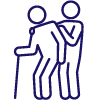- Yokohama-shi Top Page
- Kanazawa Ward Top Page
- Health, Medical and Welfare
- Welfare and nursing care
- Community welfare and health
- Kanazawa Ward Support Guide for People Needing Assistance
- Welfare shelter (Special evacuation sites)
Here's the text.
Welfare shelter (Special evacuation sites)
Last Updated May 15, 2023
For those who have difficulty evacuating at evacuation shelter or at home in the event of a large-scale disaster, Yokohama has concluded agreements with social welfare facilities in the city and positioned it as a special evacuation sites.
From April 2018, the name was changed to "welfare shelter" widely used throughout the country.
(1) What is the Welfare Evacuation Center (Special evacuation sites)?
- If a large-scale disaster causes enormous damage and becomes unable to live at home, you will have to live an evacuation life in evacuation shelter, such as elementary and junior high schools.
- For those who need assistance such as the elderly, children with disabilities, pregnant women, infants, etc., those who have difficulty in evacuation life in gymnasiums, etc., each evacuation shelter will secure space for those who need assistance.
→Nevertheless, welfare shelters are secondary shelters to accommodate those who find it difficult to evacuate in evacuation shelter.
(2) Evacuation to welfare evacuation centers
- Those who have difficulty maintaining their lives at evacuation shelter or at home and need special care.
- Professionals (public health nurses) check the situation of the person and the presence or absence of certification for long-term care, and determine the necessity of evacuation to a welfare evacuation center.
- In order for welfare shelters to fulfill the necessary functions and roles, those who are not judged to be eligible cannot evacuate.
- Welfare shelters are not always opened immediately after a disaster occurs.
- In principle, travel from evacuation shelter must be done by the person or family.
(3) Target facilities
Social welfare facilities that have concluded agreements with the ward office (elderly facilities, facilities for the disabled, community care plazas, etc.)
(4) Q&As
Q: What kind of facility is a welfare shelter? What kind of equipment and support do you have?
A: It is social welfare facilities such as facilities for the elderly, facilities for the disabled, and community care plazas that have concluded agreements with the ward office.
In an environment where people in need of assistance can easily live, such as the facilities being barrier-free, you can receive support as much as possible depending on the situation of the facilities.
Even if it is a welfare evacuation center, you will have to live an evacuation life while helping each other in cooperation with surrounding evacuees.
Q: When will welfare shelters be opened? Who can evacuate?
A: Welfare shelters are not always opened immediately after a disaster occurs.
The ward office requests the establishment sequentially from facilities that have been confirmed and have been prepared for operation.
In order to make effective use of limited resources, it is necessary to identify the situation of people requiring assistance after the disaster and evacuate from those with the highest priority.
Q: What are the criteria for accepting welfare shelters? Who decides how and how?
A: Since the facilities that serve as welfare shelters are limited, it is difficult to accept all eligible people at once.
Professionals (public health nurses) judge those who have evacuated to evacuation shelter (or from information on people requiring assistance collected in evacuation shelter) who need more assistance.
Based on the judgment of professionals, etc., the ward office decides who to accept at which welfare evacuation center.
(5) Agreement concluded facilities
| Facility type | Name | Location: |
|---|---|---|
| Special elderly nursing homes※ | Tomioka haze | 2-1-6, Tomiokahigashi, Kanazawa-ku |
| Special elderly nursing homes※ | Wakatake Tomioka | 2-1-5, Tomiokahigashi, Kanazawa-ku |
| Special elderly nursing homes※ | Noukendai, Yokohama-shi Home | 2-4, Noukendaihigashi, Kanazawa-ku |
| Special elderly nursing homes※ | Wakakusa | 2-12-1, Deiki, Kanazawa-ku |
| Special elderly nursing homes※ | Mihama, Kanazawa Home | 4-12-1, Kamariyahigashi, Kanazawa-ku |
| Short-term admission facilities for the elderly | Kanazawa Short Stay Center | 2-2, Noukendaihigashi, Kanazawa-ku |
| Elderly Welfare Center | Haruarashi Kanazawa | 1-21-5, Deiki, Kanazawa-ku |
| Community Care Plaza | Yokohama City Namiki Community Care Plaza | 2-5-31, Tomiokahigashi, Kanazawa-ku |
| Community Care Plaza | Rokuura Community Care Plaza, Yokohama City | 5-20-2, Mutsuura, Kanazawa-ku |
| Community Care Plaza | Yokohama Mudgame Community Care Plaza | 1-21-5, Deiki, Kanazawa-ku |
| Community Care Plaza | Tomioka Community Care Plaza, Yokohama | 7-16-1, Tomiokanishi, Kanazawa-ku |
| Community Care Plaza | Kamariya Community Care Plaza, Yokohama City | 2-8-1, Kamariyaminami, Kanazawa-ku |
| Community Care Plaza | Nomidai Community Care Plaza, Yokohama City | 2-1, Noukendaihigashi, Kanazawa-ku |
| Community Care Plaza | Nishi-Kanazawa Community Care Plaza, Yokohama | 3-22-3, Kamariyaminami, Kanazawa-ku |
| Community Care Plaza | Tomioka Higashi Community Care Plaza, Yokohama City | 4-13-3, Tomiokahigashi, Kanazawa-ku |
| Community Care Plaza | Yanagimachi Community Care Plaza, Yokohama City | 1-4, Yanagicho, Kanazawa-ku |
| Community Care Plaza | Nishishiba Community Care Plaza, Yokohama City | 343-5, Shibamachi, Kanazawa-ku |
| Rehabilitation facilities | Seisei Gakuen | 4-13-2, Tomiokahigashi, Kanazawa-ku |
| Rehabilitation facilities | Voyage | 2-8-1, Kamariyaminami, Kanazawa-ku |
| elementary school student Nursing Home | Miharu Gakuen, Yokohama City | 3-21-19, Tomiokahigashi, Kanazawa-ku |
| Local Activities Home | Local Activities Home Apple Forest | Nokendai Fureaikan 2-4 Nomidai-Higashi, Kanazawa-ku, 1F |
| Local Activities Home | Local Activities Home Seaside | 2-5-31, Tomiokahigashi, Kanazawa-ku |
| Local Activities Home | Local activity home Kanazawa welfare center | 6-4, Seto, Kanazawa-ku |
| Nursing care facilities for the elderly | Nokendai Partria | 10-1, Noukendaihigashi, Kanazawa-ku |
| Nursing care facilities for the elderly | Asahina | 107, Asahinacho, Kanazawa-ku |
| Nursing care facilities for the elderly | Hometown | 391-10, Shibamachi, Kanazawa-ku |
| Nursing care facilities for the elderly | Komorebi | 5-1-30, Kamariyahigashi, Kanazawa-ku |
| Special elderly nursing homes※ | Lasur Kanazawabunko | 2-10, Okawa, Kanazawa-ku |
| Special elderly nursing homes※ | Yokohama Kanazawa Shoyuen | 1-1, Machiyacho, Kanazawa-ku |
※In the event of a large-scale disaster, those who have been certified as requiring long-term care by The Long-term Care Insurance, who have difficulty living at evacuation shelter or at home and need assistance from facility staff may be accepted by emergency admission at nursing homes.
(6) Related link
Disaster countermeasures throughout the region - Guide to Assistance for People Needing Disasters (Health and Social Welfare Bureau Health and Welfare Division page)
Inquiries to this page
Kanazawa Ward General Affairs Department Ward Administration Promotion Division
Telephone: 045-788-7721
Telephone: 045-788-7721
Fax: 045-784-9580
Email address: kz-kusei@city.yokohama.lg.jp
Page ID: 403-566-008













